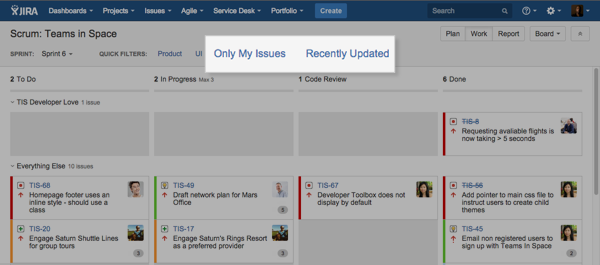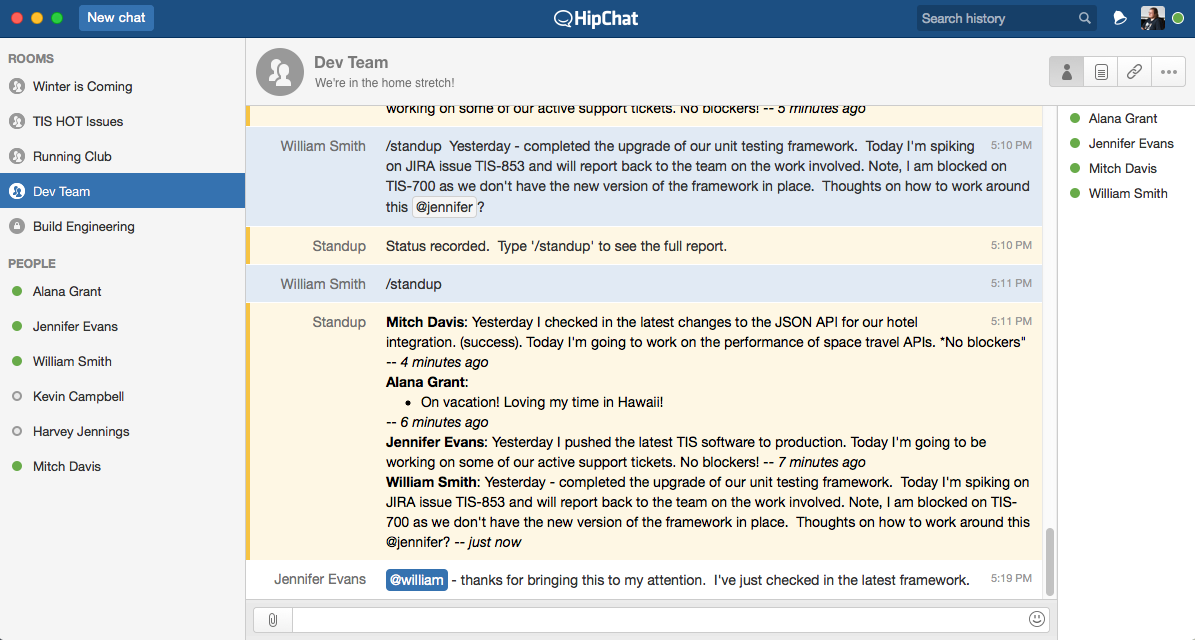In this article, we’ll talk about how to effectively manage blockers as well as offer other great tips and tricks we use at Atlassian. We want to help you make your stand-ups (and your overall agile program) awesome.
So, what is stand-up?
In many sports like (American) football and rugby, the team huddles before each play. The huddle is strategic: it keeps the team informed, connected, and calibrated throughout the game. For software teams, stand-up is like the team’s huddle. It’s even commonly known as the daily scrum, and reinforces “we” to keep everyone aware of the team’s landscape and progress.
For software teams, stand-up is like a sports team’s huddle.
Tweet
//
Said another way, stand-up is a daily meeting that involves the core team: product owners, developers, and the scrum master. This meeting’s flavor is unique to each team, but at Atlassian we use three simple questions to generate structure:
- What did I work on yesterday?
- What am I working on today?
- What issues are blocking me?
These questions highlight progress and help flag team blockers. Also, it strengthens the team when everyone shares the progress they’re contributing to the team. The daily reinforcement of sharing individual successes and plans keeps everyone excited about the team’s overall contribution to the organization.
At the individual level, it’s important to walk into stand-up knowing what you’re going to say. It keeps the energy of the stand-up high and everyone engaged. At Atlassian, individuals use Jira Agile boards to keep on top of their projects with quick filters. Two great filters that can be used together to help prepare for stand-up are “only my issues” and “recently updated.” When these two filters are used together, they show the issues assigned to you and that have been updated in the last day.

ProTip: One popular customization of the Only My Issues filter is to add the participants field from the Jira Toolkit Add-on. This adds any issues you’ve touched rather than just issues assigned to you. The JQL for that filter would be:
assignee = currentuser() or participants in (currentuser())
Stand-ups at Atlassian
Stand-ups are not a one-size-fits-all meeting. At Atlassian, each team has a personalized stand-up to keep everyone involved and engaged. No two are exactly alike.
Let’s dig into what makes a great stand-up, and check out some of our examples.
- Choose a time that works for everyone – At Atlassian, most stand-ups for co-located teams happen between 9 and 10 a.m. It gives everyone time to get context for the day and doesn’t require everyone to be an early riser on the team. For teams spread across different geographies, choose a time that works for all people. For example, the Jira Service Desk team is spread between San Francisco and Sydney. Their stand-up is at 3:30 p.m. San Francisco time. Sure, an afternoon stand-up is a bit non-conventional, but it’s a great way to stay in touch with colleagues across the globe in Sydney.
- Keep stand-up efficient – Many teams at Atlassian informally time their stand-ups to keep everyone focused and to keep stand-up efficient. Rotate who keeps time to make sure everyone is accountable and invested. Limit the duration of stand-ups to 15 mins–max. Have a smaller team? Make it a practice to keep the stand-up even shorter.
- Play catch – The Jira team tosses a beachball between team members to keep everyone engaged. No one can toss the ball to someone next to them or to someone who has already gone. No zoning out! If you haven’t tried the technique, it’s a great way to keep everyone involved.
- Make stand-up a part of the team’s retrospective – Stand-up is a part of many agile cultures, but it doesn’t mean that the team can’t discuss the effectiveness of stand-up in retrospectives. Some Atlassian teams meet daily. Others meet three times a week. The Jira Agile team regularly discusses how to make stand-up better for the team in retrospectives. If the team isn’t finding value in stand-up, discuss why. Make some changes! Stand-up is agile itself.
Hipchat + stand-up for distributed teams
At Atlassian we have team members all over the globe: in one of our 12 offices or otherwise working remotely. We rely on Hipchat to keep everyone connected across geographies. Each team at Atlassian has a team room that keeps everyone in touch with one another. One feature of Hipchat is the integration with external services that automate routine processes (bots). We use two bots: Stand-up bot and Chatty to keep everyone connected.
Stand-up Bot
The stand-up bot makes it easy to report and retrieve statuses for stand-up, especially for teams in different time zones. To integrate the stand-up bot visit http://botlab.hipch.at/ and connect it with your Hipchat room. When it’s time for stand-up just type the following command in your team’s room:
/standup
Everyone can report in asynchronously and it’s easy to query the room to see what’s going on across all team members. Just type
/standup
and the bot will return everyone’s stand-up report.

Chatty
Chatty is another bot that gives a gentle reminder to the team’s room that it’s time for stand-up. You can find out more about Chatty on BitBucket.

Stand-up brings the team together to highlight progress and keep everyone aware of what’s going on across the team. Whether you’re a collocated or a distributed team, stand-up makes the team more connected and productive. The trick over the long term is to keep it light and fun to maintain engagement and reduce the negative effect of dull routines.
Hungry for more? Check out The Agile Coach – a site with articles, webinars, and ebooks on all things agile.
